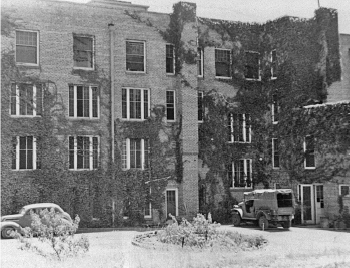

WWII
Interrogation Camp
A The decade of the 30's was the decade of decline for Byron Hot Springs. As the first prisoners of war arrived in the United States, the War Department recognized a need for special camps for a specific purpose. Two such camps were set up and referred to in official records as ''Interrogation Centers." One Center was created on each coast. Fort Hunt was created at Alexandria, Virginia, and the other at Byron Hot Springs. "Camp Tracy," as the top secret post was to be known, was under the command of Colonel Rhodes F. Arnold, U.S. Army. The Interrogation Centers were considered by the Army as "Temporary Detention Centers" for the specific purpose of interrogating certain prisoners of war captured either by the army or navy.
A memorandum dated May 12, 1942, originating in the War Department, Office of Engineers, directed an interrogation center to be provided on the west coast. Byron Hot Springs was selected. Ten thousand dollars was allocated to initiate steps to acquire and prepare "Camp Tracy'' for receiving prisoners, and the Sacramento District Engineers Office was assigned to job of making the necessary alterations, repairs and new construction.
The same records indicate that the camp divided into two areas. The portion of the reservation inside the inner fence of the prison enclosure was known as the interrogation center, which was operated by the Chief of Military Intelligence; the outer area reserved for barracks, mess halls, and recreation. The interrogation center was divided into two sections, the Japanese section and the German section. During 1944, there were about 921 Japanese prisoners and 645 Germans interrogated. The same report shows that the maximum number of prisoners on hand at any one time did not exceed fifty-one. In each section there were maps draw from the information resulting from interrogations, decoding rooms, and rooms in which information was gathered through hidden microphones in the general prisoner quarters. It was reported that all buildings used by the prisoners were electronically bugged. The information gathered in this manner at Camp Tracy, may well have decided the outcome of some of the critical campaigns of the war.
While the army leased the Byron Hot Springs, they remodeled the hotel, a pump house, a firehouse, eleven cabins and built a garage and laid several miles of underground sewer lines. Other improvements were made buy orders from the War Department. Camp Tracy was declared surplus property after the war and the leased partially deactivated about August 1, 1945. The camp was ordered closed by September 1, 1945. Such equipment and improvements to be used at other installations were removed when the army released the property. The property again became known as Byron Hot Springs.
Greek '60s - '70s [next] [last] [back to the top]
Home l Resort Plans l History l Golf Course l Resort Store l Newsroom l Contact Us
© 2004 Byron Hot Springs
